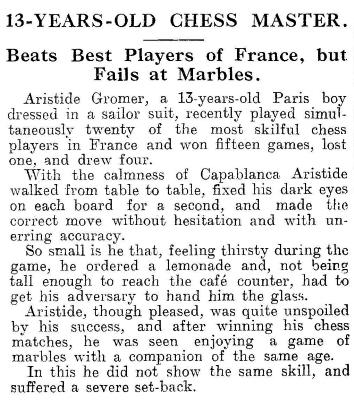
Edward Winter
(2003, with updates)
French chess historians, to the extent that the breed exists, have done little research into their country’s top players of the past. What, for instance, is known about the three-time French champion Aristide Gromer?
An early mention of him, on page 17 of the January 1922 La Stratégie, plunges us into complications from the outset. His surname was spelt ‘Grommer’, and he was described as the young nephew of the late Jacques Grommer. Certainly page 65 of the March 1921 La Stratégie had reported the latter’s recent death, in New York, but Jeremy Gaige’s Chess Personalia noted that the obituary was incorrect and that Jacques G. died in St Louis, MO, USA circa 1928. No explanation for the Grommer/Gromer spelling discrepancy is available. Concerning Aristide, Gaige recorded only that he was born in 1909.
The January 1922 French magazine reported that the previous month Aristide Gromer had finished equal first with Michel Barkan in a 28-player tournament organized by Eugène Chatard to test the ‘new Chatard Opening’: 1 e4 e5 2 f4 d5 3 Nf3 Bg4 4 Nc3 d4 5 Bb5+ c6 6 Bc4 and now either 6…dxc3 or 6…Bxf3.
The February 1923 La Stratégie (page 42) related that a solving contest (12 problems) held in Paris had yielded the following result: 1st A. Goetz (12 points); 2nd J. de Villeneuve Esclapon (10); 3rd A. Alekhine (9); 4th A. Gromer (8); 5th P. Fauret (2).
In 1923 Gromer’s name also began to appear abroad. Page 198 of the April 1923 Chess Amateur quoted from the Daily Mail:
‘Aristide Gromer, a 13-year[s]-old boy, dressed in a sailor suit, [recently] played simultaneously 20 of the most skilful chessplayers in France and won 15 games, lost one and drew four. With the calmness of Capablanca, Aristide walked from table to table, fixed his dark eyes on each board for a second and moved the pieces without hesitation [and made the correct move without hesitation and with unerring accuracy]. So small is he that, feeling thirsty during the game, he ordered a lemonade and, not being tall enough to reach the café counter, had to get one of his adversaries [his adversary] to hand him the glass. Aristide, though pleased, was quite unspoiled by his success, and after winning his chess matches he was seen enjoying a game of marbles with a companion of the same age. In this he did not show the same skill and suffered a severe set-back.’

Daily Mail, 5 April 1923, page 8
Next an excerpt from page 136 of the April 1923 BCM:
‘A correspondent of ours in Paris, in answer to our inquiry, says that young Grom[m]er has made very great progress in the few years that he has played chess and is now one of the best players of the Palais-Royal. He is quite of second-class strength, very sure, solid, playing with good judgment and without errors or wild combinations. In his simultaneous display he showed great sang froid and calm. Our correspondent thinks that the boy may become very good; but he is not robust, and therefore it is not safe to predict too much.’
The American Chess Bulletin (May-June 1923 issue, page 98) also picked up the news of Gromer:
‘According to Paris correspondence under the date of 21 March, appearing in the New York papers of 10 April, a schoolboy prodigy, 13 years old, has been developed in the French capital in the person of Aristide Gromer, who, sometime before, played 20 of the “best players of Paris”, simultaneously. Making all due allowance for the entirely unnecessary exaggeration, the youngster acquitted himself grandly by making a score of 15 wins, four draws and one loss. Somewhat naively the report goes on to say that the boy is “far from the record of games played simultaneously by one person”, and then mentions Marshall’s record of 155 games in Montreal.’
Pages 193-194 of the August 1923 La Stratégie published the following game with annotations from L’Eclaireur du Soir by Georges Renaud (who called Gromer ‘un précoce garçonnet de 14 ans’):
Aristide Gromer – Victor Kahn
Cercle Philidor Tournament, Paris, 22 May 1923
French Defence
1 e4 e6 2 d4 d5 3 Nc3 Nf6 4 Bg5 dxe4 5 Nxe4 Be7 6 Bxf6 Bxf6 7 Nf3 Nd7 8 Bd3 O-O 9 O-O Qe7 10 c3 c5 11 dxc5 Nxc5 12 Nxc5 Qxc5 13 Qe2 g6 14 Nd2 Bg7 15 Ne4 Qc7 16 f4 b6 17 Qf2 Bb7 18 Qh4 Rfd8 19 Bc2 Qc6 20 Qf2 Rd7 21 Ng5 Qc4 22 Bb3 Qc5 23 Qxc5 bxc5 24 Rad1 Rad8 25 Rxd7 Rxd7 26 Nxe6 Rd2 27 Nxc5 Rxg2+ 28 Kh1
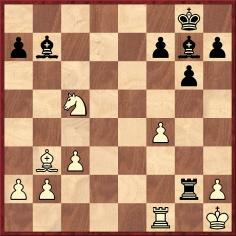
28…Ba8 29 Rd1 Rg5+ 30 White resigns.
Gromer’s three national titles were to come in the 1930s, and during that decade he also toured Spain. As will be seen below, that earned him a fierce attack, on ethical grounds, by none other than G. Koltanowski.
(2945)
In the mid-1930s Aristide Gromer was one of many figures (Alekhine, Capablanca, Flohr, Koltanowski and Lilienthal were others) who toured Spain giving simultaneous exhibitions, and it seems that the highlight of the Frenchman’s stay occurred in Lugo. El Ajedrez Español, January 1935 (page 143) reported that he had given a display on 128 boards, scoring +105 – 6 =17 in ten hours. The magazine published a number of games played by Gromer during his visit (none particularly striking), and on page 334 of the July issue he wrote a brief article flattering Spanish chess.
On page 472 of the October-November El Ajedrez Español G. Koltanowski wrote mild criticism of Gromer’s conduct in Spain, but the same adjective hardly applies to the attack he launched on page 78 of the 14 October 1935 issue of CHESS:
‘I am going to write some very unpleasant things about Gromer, and I hope he reads them. He has victimized Spanish chess circles long enough and is doing the game a lot of harm, and I am publishing these details at the request of the committee of the San Sebastián Club, in the hope that they might save a few people from him who might otherwise be duped.
Gromer’s habit is to turn up suddenly in some small town, announce that he is penniless and beg the president of the chess club to arrange a simultaneous display for him. A display is arranged, and he receives a large fee. Now, instead of leaving, he stops. A few days later he calls again and reveals that he has borrowed large sums of money from various members: just arrange one more simultaneous display and he will pay off the debt and leave! Again a display is organized but instead of paying off the debt, he pays half. A week later he turns up and asks for another display to pay the remainder of the debt off. By the time the club gets rid of him he has mortgaged their finances so badly that they are unable to plan any sort of ambitious programme for years to come.
In San Sebastián he has not even paid back his debts. The last display he gave there was at three pesetas a board, an absurdly high fee. And they can’t get rid of him: he is staying at the best hotel and they are wondering who is going to pay the bill.’
We make no comment on the above reportage, except to reiterate that Koltanowski’s lifetime track-record of inaccuracy is such that rigorous scepticism is required concerning anything written by him, whether malignant or benignant.
(2946)
Page 148 of Kings, Commoners and Knaves and page 293 of Chess Facts and Fables discussed the origins of the term ‘Dragon Variation’ in the Sicilian Defence, and the earliest citation we have found comes only from the mid-1920s, on page 43 of the February-March 1925 Tijdschrift van den Nederlandschen Schaakbond. After 1 e4 c5 2 d4 cxd4 3 Nf3 Nc6 4 Nxd4 Nf6 5 Nc3 d6 6 Be2 g6, H. Weenink referred to ‘De “drakevariant” van den Siciliaan’.
Pre-1925 citations are sought, and in the meantime we quote an author who considered the Dragon Variation to be a line for White. The game below was annotated on pages 52-53 of Les échecs par la joie by Aristide Gromer (Brussels, 1939), and we give only the notes relevant to the ‘Dragon’ name:
Aristide Gromer – A. Baulier [‘Beaulier’]
French Championship, Toulouse, 1937
Sicilian Defence
(‘... La “Sicilienne” se distingue principalement par un effort des Noirs sur l’aile Dame tandis que les Blancs portent leur activité sur l’aile Roi. La variante la plus caractéristique de cette conception stratégique est la variante dite “du Dragon”, dont nos disciples trouveront un spécimen dans la partie qui suit.’) 1 e4 c5 2 Nf3 Nc6 3 d4 cxd4 4 Nxd4 Nf6 5 Nc3 d6 6 Be2 (‘Le coup préparateur de l’avance à la dragonne future.’) 6...g6 7 Be3 Bg7 8 O-O O-O 9 Nb3 Be6 10 f4 Na5 11 f5 Bc4
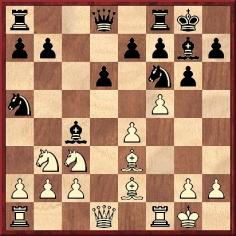
12 g4 (‘Le coup constitutif de la variante dite du “Dragon”. Il faut d’ailleurs faire bien attention à ce que le Dragon ne perde pas son souffle; car les Blancs découvrent leur Roi et une contre-attaque des Noirs serait des plus dangereuses.’) 12...Rc8 13 Bd4 a6 14 g5 (‘Dans ce genre d’attaques à la dragonne, il ne faut pas perdre de temps.’) 14...Bxe2 15 Nxe2 Nh5 16 Bxg7 Nxg7 17 Nbd4 Nc4 18 Qc1 d5 19 b3 Ne5 20 f6 exf6 21 gxf6 Nh5 22 Qg5 Nd7 23 e5 Re8
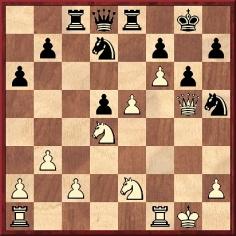
24 e6 Ndxf6 25 exf7+ Kxf7 26 Nf4 Qb6 27 Rad1 Nxf4 28 Rxf4 Kg7 29 Kh1 Re4 30 Rxe4 dxe4 31 Nf5+ Resigns. (‘L’attaque du “Dragon” est une attaque dangereuse. Elle doit être conduite de la part des Blancs avec célérité (comme toutes les attaques) car les Noirs ont d’intéressantes possibilités de contre-attaque.’)
Have other writers used ‘Dragon Variation’ for the pawn advance g2-g4 in the Sicilian Defence? We wonder too how well known the term was in any context during Gromer’s career. For instance, pages 571-572 of L’Echiquier, February 1927 had a French translation of Kmoch’s annotations to a game (Kostić v Canal, Meran, 1926) which began 1 e4 c5 2 Nf3 Nc6 3 d4 cxd4 4 Nxd4 g6; the note to Black’s fourth move included a reference to ‘La “Drachen” variante choisie ici’, implying unawareness that use was being made of a German term for the Dragon Variation.
We still have no information about Gromer from the 1940s onwards. The picture below was published opposite page 80 of El Ajedrez Español, November 1934.
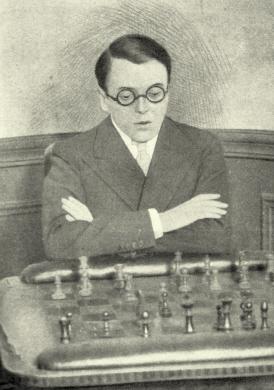
Aristide Gromer
(5135)
Page 20 of Les échecs par la joie by Aristide Gromer (Brussels, 1939) asserted that Ruy López was Montaigne’s cousin. On what grounds?

(5188)
Dominique Thimognier (St Cyr sur Loire, France) provides some additional information on the three-time champion of France:
‘Gromer remained in South America after the Buenos Aires Olympiad in 1939, and there are records of his participation in tournaments in Argentina and Brazil in 1940 and 1941. The date of his return to France is not yet known, but he played in the French championship in Rouen, 1947. Reminiscences by Robert Bellanger on page 233 of Echecs Français, October 1979 stated that Gromer died at the hôpital Sainte-Anne in Paris, a psychiatric institution, but no date was given.’
Gromer is seated on the far right in this photograph from page 188 of the July 1932 issue of El Ajedrez Americano:
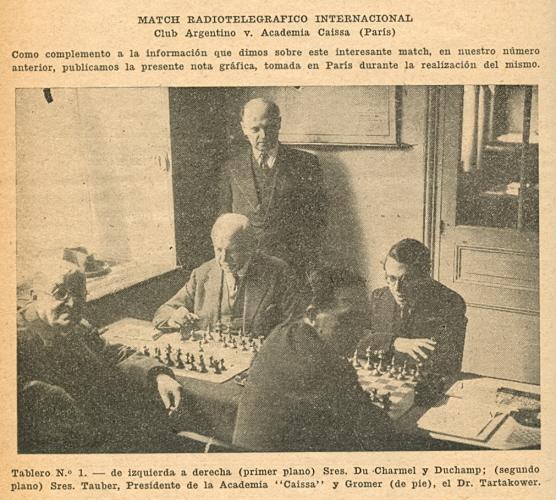
(5487)
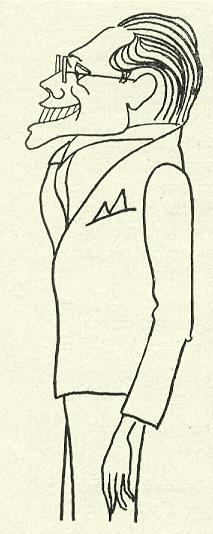
Aristide Gromer (El Ajedrez Español, October-November 1935, page 472)
Dominique Thimognier informs us that he has produced a page about Aristide Gromer on his Héritage des échecs français website.
(5847)
From page 118 of CHESS, May 1941:
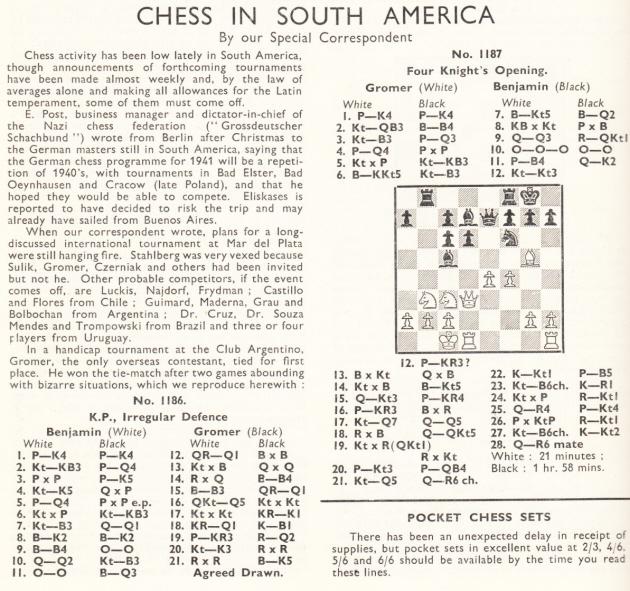
1 e4 e5 2 Nf3 d5 3 exd5 e4 4 Ne5 Qxd5 5 d4 exd3 6 Nxd3 Nf6 7 Nc3 Qd8 8 Be2 Be7 9 Bf4 O-O 10 Qd2 Nc6 11 O-O Bd6 12 Rad1 Bxf4 13 Nxf4 Qxd2 14 Rxd2 Bf5 15 Bf3 Rad8 16 Ncd5 Nxd5 17 Nxd5 Rfe8 18 Rfd1 Kf8 19 h3 Rd7 20 Ne3 Rxd2 21 Rxd2 Be4 Drawn.
1 e4 e5 2 Nc3 Bc5 3 Nf3 d6 4 d4 exd4 5 Nxd4 Nf6 6 Bg5 Nc6 7 Bb5 Bd7 8 Bxc6 bxc6 9 Qd3 Rb8 10 O-O-O O-O 11 f4 Qe7 12 Nb3 h6 13 Bxf6 Qxf6 14 Nxc5 Bg4 15 Qg3 h5 16 h3 Bxd1 17 Nd7 Qd4 18 Rxd1 Qb4 19 Nxb8 Rxb8 20 b3 c5 21 Nd5 Qa3+ 22 Kb1 c4 23 Nf6+ Kh8 24 Nxh5 Rg8 25 Qh4 g5 26 fxg5 Rb8 27 Nf6+ Kg7 28 Qh6 mate.
A brief item on Gromer from page 3 of the Democrat-Forum (Maryville, Missouri), 26 April 1923:
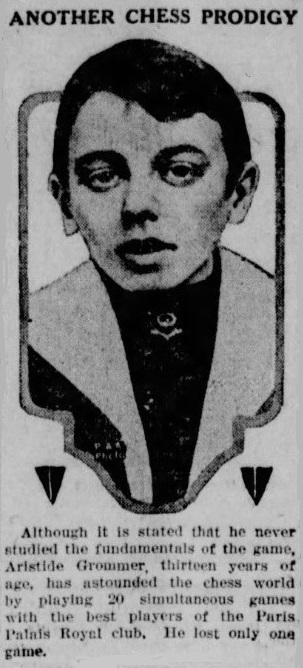
(9159)
Dominique Thimognier (Fondettes, France) reports that his article on Gromer has been substantially updated since we first drew attention to it, in C.N. 5847. In particular, it is now recorded that Gromer was born in Dunkirk on 11 April 1908 and died on 6 July 1966 in Plouguernével.
Our correspondent also sends the last game of Gromer’s that he has found, a loss as Black to Maurice Raizman in the sixth round of the French championship in Rouen on 10 September 1947: 1 d4 Nf6 2 c4 e6 3 g3 d5 4 Bg2 dxc4 5 Qa4+ Nbd7 6 Qxc4 c5 7 Nf3 Nb6 8 Qd3 Be7 9 Nc3 O-O 10 O-O Nfd5 11 dxc5 Nxc3 12 Qxc3 Na4 13 Qc2 Nxc5 14 Rd1 Qe8 15 Be3 Na6 16 Ne5 Nb4 17 Qb3 a5 18 a3 a4 19 Qc4 b5 20 Qc7 Nd5 21 Rxd5 exd5 22 Bxd5 Bd8 23 Qc5 Rb8 24 Qd6 Bf6 25 Nxf7 Bb7 26 Ba2 Rxf7 27 Qc7 Be5 28 Bxf7+ Qxf7 29 Qxe5 Qe8 30 Qxe8+ Rxe8 31 Rc1 Bd5 32 Rc7 h5 33 h4 Bc4 34 Kf1 Rd8 35 f3 Rd1+ 36 Kf2 Rh1 37 Bd4, and Gromer resigned on move 63. The game was published in La Nation Belge, 21 September 1947 and was annotated by Camil Seneca on page 83 of L’Echiquier de Paris, October 1947.
(9182)
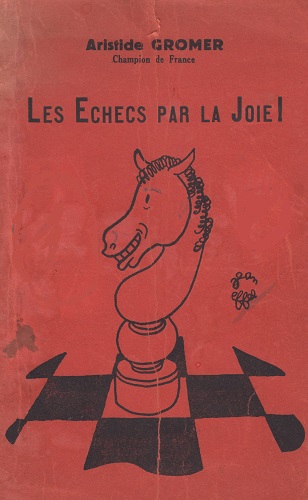
From page 5 of Les échecs par la joie by Aristide Gromer (Brussels, 1939):
‘Depuis Jésus-Christ, quantité de personnages illustres ont dédié une partie de leur temps au jeu d’échecs.’
Page 105 of the July 1940 Schweizerische Schachzeitung had a text-book example (by Jean-Charles de Watteville, with ‘Auguste’ instead of Aristide) of a damning review which ends on an artificially positive note:
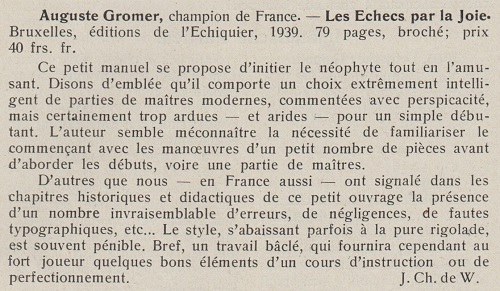
(10154)
From our feature article Chess Photographs in the Daily Mirror:
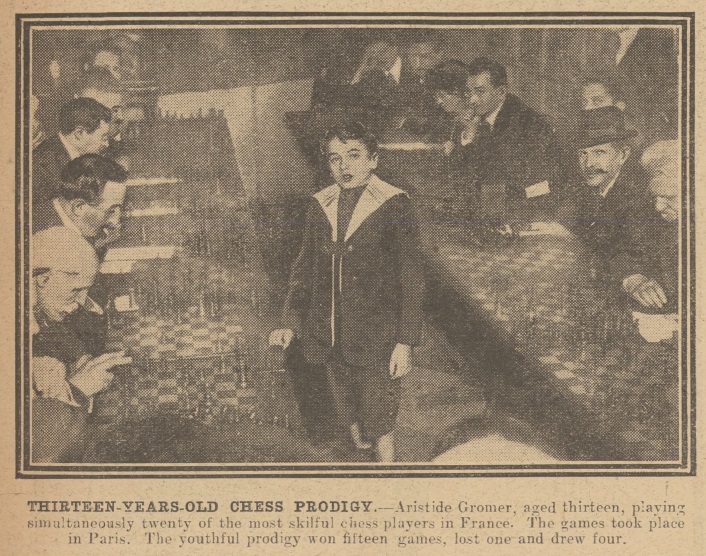
8 March 1923, page 10
Addition on 16 February 2022:
Carlos Drake (Buenos Aires) provides this document:
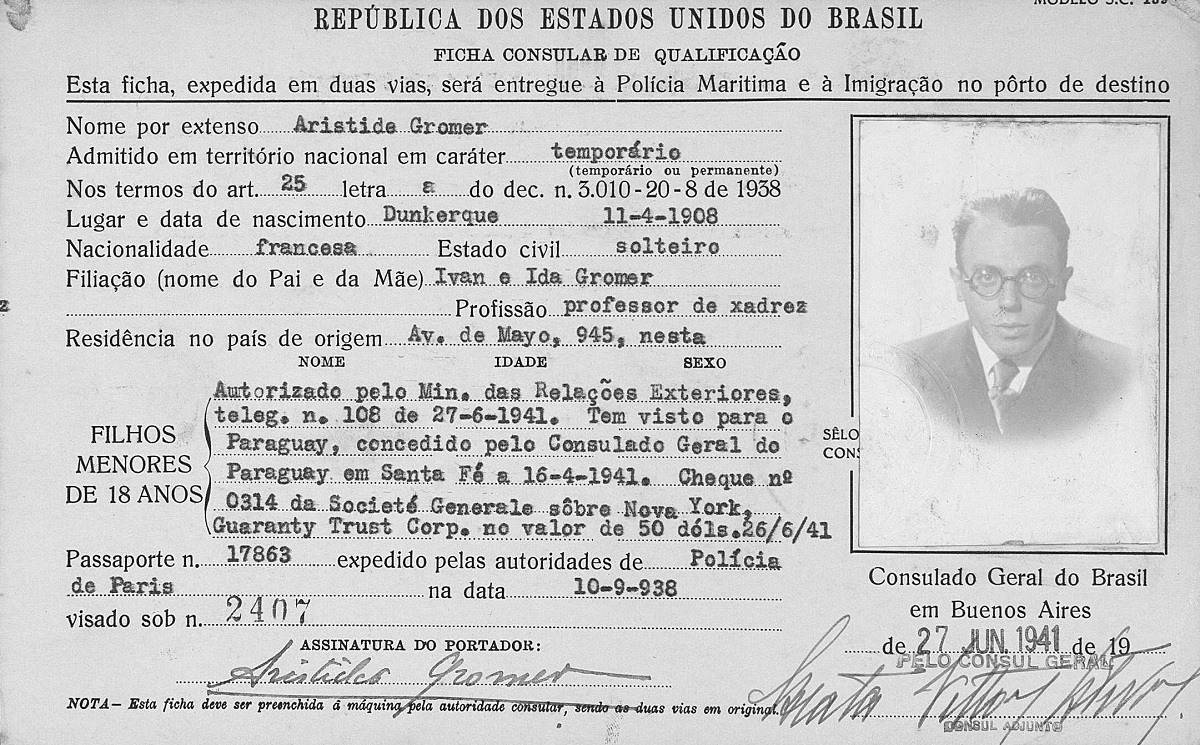
Our correspondent also sends the following photograph (Club Atlético Independiente, Dolores, Buenos Aires province, 18 December 1939) with a key:
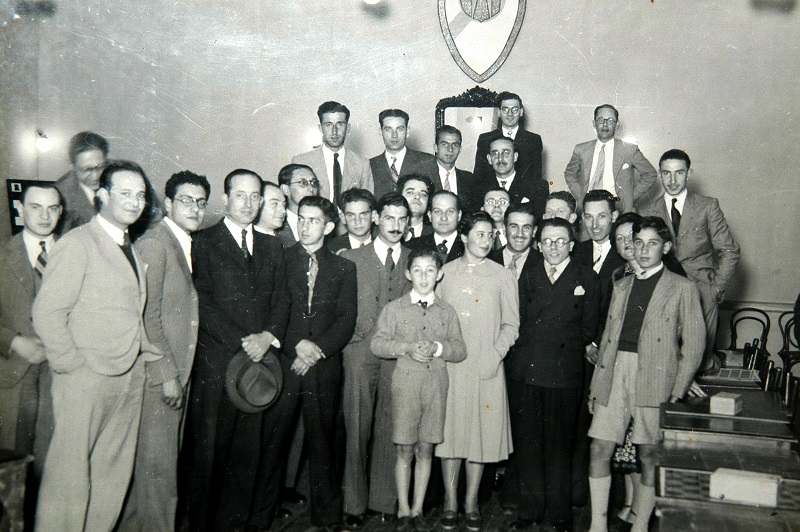
From left to right: 1. ?; 2. Guillermo Donadío; 3. Angel Latuf; 4. Federico Latuf; 5. ?; 6. Juan Antonio Chapperón; 7. José Ramón Eyras; 8. Osmar Scheggia; 9. Arturo Enrique Eyras; 10. Santos Guerbi; 11. Abel Bartolomé; 11. Manuel González; 13. Victorio Formentini; 14. Omar Doumic; 15. Lucio Régulo Eyras; 16. Eduardo Natalio Giotta; 17. Julio F. Galindo; 18. Roberto Repetto; 19. Susana D’Angelo; 20. Mario Fortini; 21. Desiderio Gilabert; 22. Aristide Gromer; 23. Urbano Eyras; 24. Julio Héctor Quenard; 25. Isabel Eyras; 26. Jorge Osiris Eyras; 27. Néstor Maffezzini.
To the Chess Notes main page.
To the Archives for other feature articles.
Copyright: Edward Winter. All rights reserved.